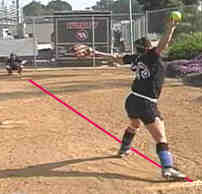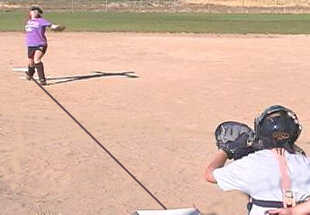by Gerald Warner, Softball
Pitching Instructor


The "Power Line" (sometimes called the "line of force") is an
imaginary line from the center of the pitching rubber to the rear
point of home plate. As the name implies, a pitcher who
steps straight ahead with her stride leg can get maximum
POWER…if the stride foot touches against the power line when
landing.
Experience has shown that a majority
of female softball pitchers will be better balanced, AND will also
have a faster pitching speed…with better
accuracy
SIDE-STEPPERS - Many pitchers have been taught to
intentionally "side-step"… meaning that for right handed throwers,
the stride foot comes down to the left of this center line (or for
stepping left handers, the foot lands several inches right of the
power line). For some girls, side-stepping will
work…particularly very young or just-starting pitchers who have a
problem "closing" (rotating the body at the end of the
pitch). The same is true for some stepping-style (shorter
step…no leap) pitchers… those who might be taller or weightier
than some of their counterparts. Larger pitchers often rely
on upper body and arm strength, not fully utilizing their hip or
full body to throw a fastball, and consequently feel they have
better balance and can get a minor push-to-the-side advantage by
side-stepping.
Side-stepping is fine for some, but
most others improve their speed and accuracy by focusing all of
their energy (used in the push-off, arm circle,
rotation of the body, the release, & follow-through)
right down the power line toward home plate, stepping
straight ahead, and landing with the stride foot on (or
at least touching against) the power line. Whether
using the on-the-power-line stride, or the side-step
stride, the key consideration for every pitcher is doing what
helps her maintain balance.
CONTROL AND
ACCURACY
Do you occasionally throw pitches either
inside or outside, and can't seem to correct the problem? One
of the little-known potential solutions is to change
where or how your stride foot is landing:
(1) Land your foot at a slight
angle…toes angling right for a right-handed pitcher (left for a left-hander) at an angle of 30 to 45
degrees (the 1:00 or 1:30 position).
If it lands pointed straight
toward the plate, a right-handed pitcher will likely
throw to the left (outside to a right-handed
batter). A left-handed pitcher will likely
throw to the right.
If
the foot lands at too sharp of an angle (up to 90
degrees…the 3:00 position), it not only restricts the
closing rotation, but also can create short-term or permanent knee
problems.

(2) Land with the toe of
your stride foot on the power
line.
Here is a
secret: Many pitchers who have a problem with too many
inside pitches (right-handed pitcher who
throws inside on a right-handed batter, or
vice-versa for left-handed pitchers) can regain accuracy by
stepping on or against the power line.
Using a right-handed pitcher as
the example, if you step too far to the left, you will often throw
inside to a right-handed batter (it sounds like it
should just be the reverse of that, doesn't it?). The
reason is that when you side-step to the left, your right hip gets
in the way of your pitching arm as it comes around, and (subconsciously) you push your arm further to the
right to avoid brushing your hip, consequently throwing the ball
inside (to the
right).
If you are a
left-handed pitcher, when you step too far to the right, you
generally will throw the ball to the left side of the
plate.
Whether righty or lefty, step on (or at
least against) the power line to gain inside/outside
control.
TO MAKE A POWER LINE FOR PITCHING
PRACTICE:
Use a string or chalk line 35 to
40 feet long…nail one end in the ground at a point 3½ or 4
feet in front of the pitching rubber, in a line going to the
center of home plate from the middle of the rubber (don't start the string at the pitching rubber…the drag
foot will catch on it). Stretch the line toward home
plate and nail the other end at the (rear)
point of the plate.
The article
above can be downloaded and printed from Microsoft Word

Do you want to reprint this article or use it
on your website or in your newsletter?
As long
as it is not for profit, our only requirement is that you first
notify us, then include the following sentence:
Article by Gerald
Warner of PitchSoftball.com
and include a reference to
this website: www.pitchsoftball.com






